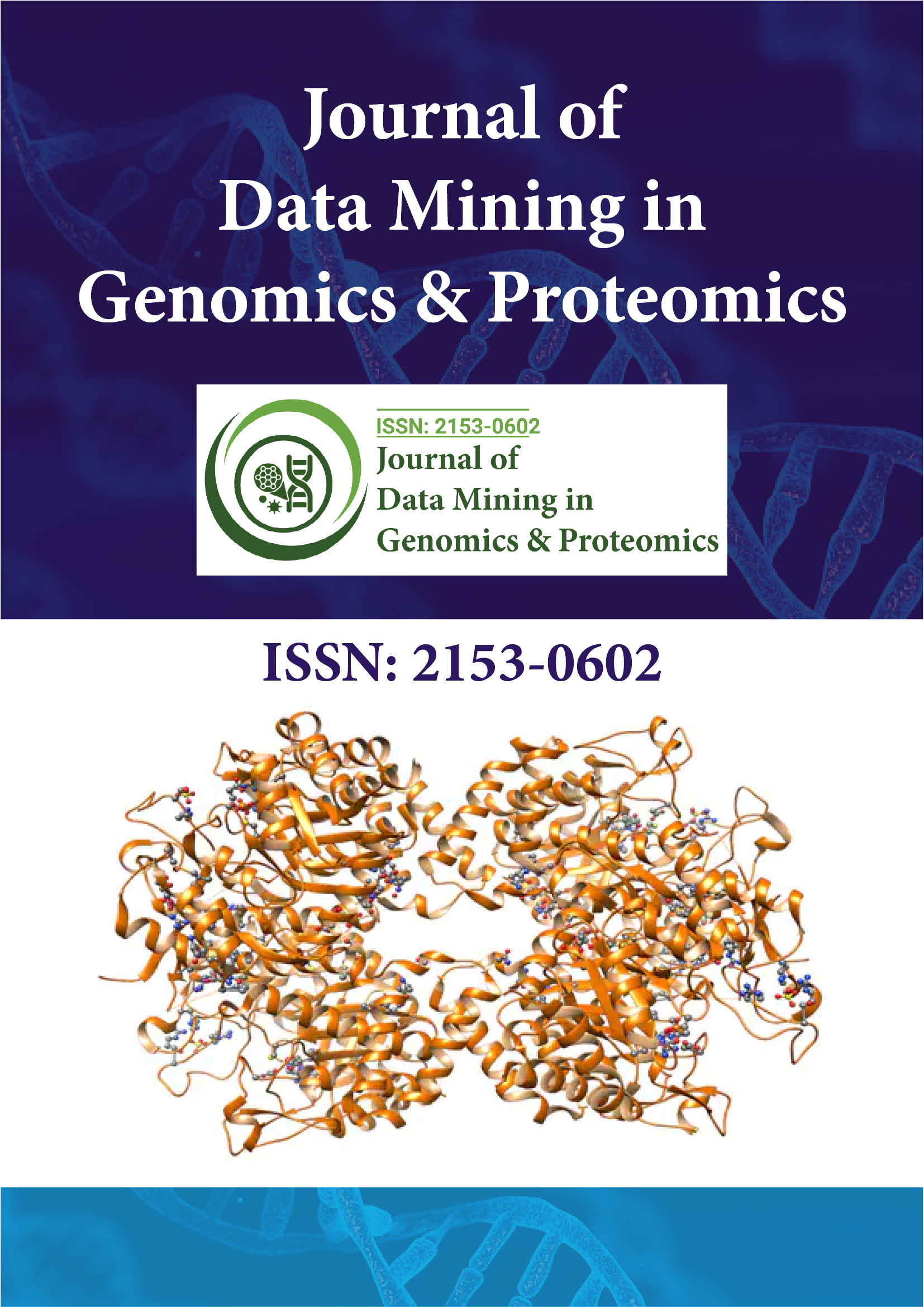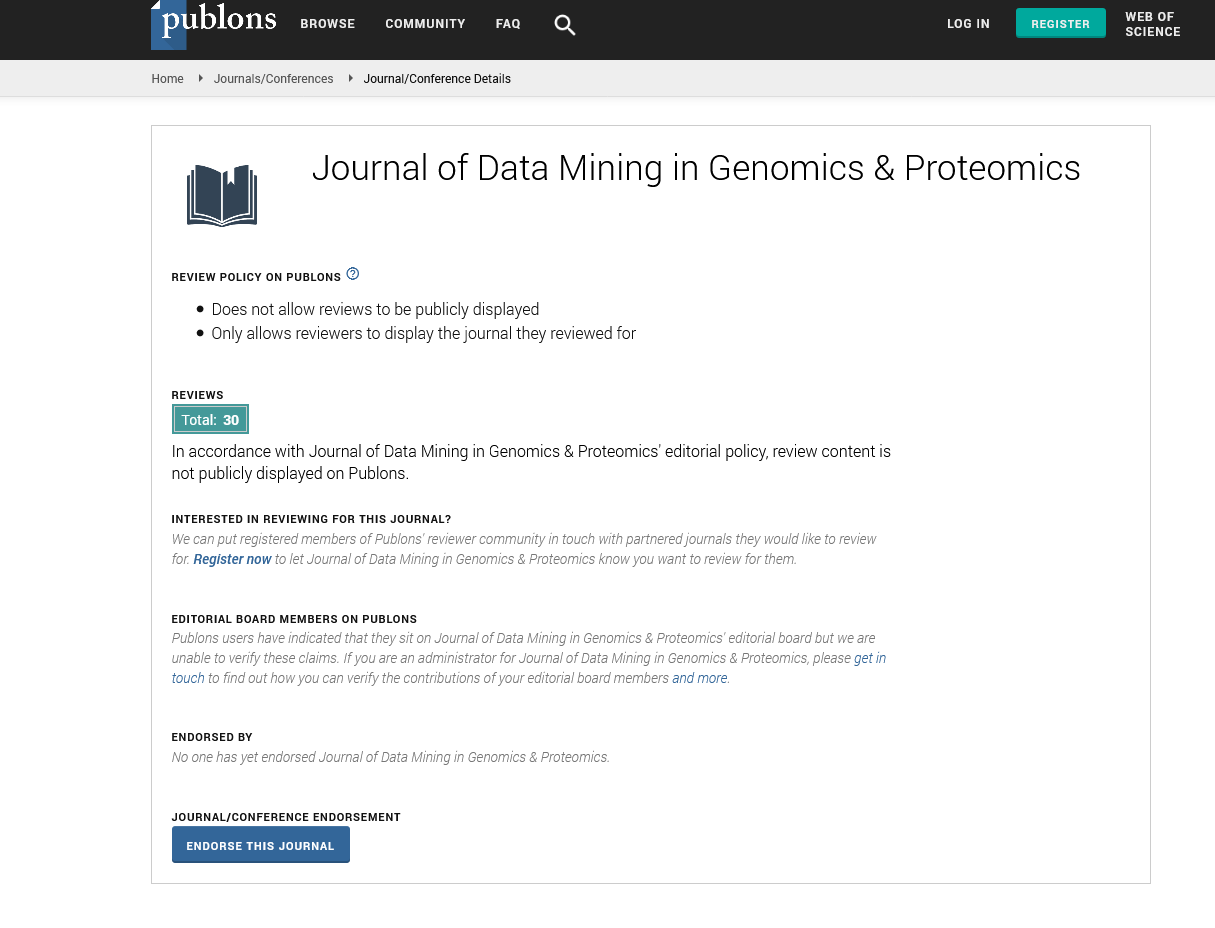Indexed In
- Academic Journals Database
- Open J Gate
- Genamics JournalSeek
- JournalTOCs
- ResearchBible
- Ulrich's Periodicals Directory
- Electronic Journals Library
- RefSeek
- Hamdard University
- EBSCO A-Z
- OCLC- WorldCat
- Scholarsteer
- SWB online catalog
- Virtual Library of Biology (vifabio)
- Publons
- MIAR
- Geneva Foundation for Medical Education and Research
- Euro Pub
- Google Scholar
Useful Links
Share This Page
Journal Flyer

Open Access Journals
- Agri and Aquaculture
- Biochemistry
- Bioinformatics & Systems Biology
- Business & Management
- Chemistry
- Clinical Sciences
- Engineering
- Food & Nutrition
- General Science
- Genetics & Molecular Biology
- Immunology & Microbiology
- Medical Sciences
- Neuroscience & Psychology
- Nursing & Health Care
- Pharmaceutical Sciences
Perspective - (2025) Volume 16, Issue 2
Proteomic Pattern Analysis in Neurodegenerative Disease Research
Markus Vogel*Received: 29-May-2025, Manuscript No. JDMGP -25-29767; Editor assigned: 31-May-2025, Pre QC No. JDMGP -25-29767; Reviewed: 14-Jun-2025, QC No. JDMGP -25-29767; Revised: 20-Jun-2025, Manuscript No. JDMGP -25-29767; Published: 28-Jun-2025, DOI: 10.35248/2153-0602.25.16.386
Description
Neurodegenerative diseases, including Alzheimer’s, Parkinson’s and Huntington’s diseases, are marked by the progressive loss of neurons, resulting in impaired cognitive and motor functions. These disorders arise from a complex interplay of genetic predispositions and environmental influences, making the underlying molecular mechanisms challenging to decipher. Proteomics has become a pivotal approach in this area, as proteins serve as the functional effectors of genetic and regulatory signals. Mining proteomic data enables the identification of disease-specific molecular signatures, providing insights into both pathological mechanisms and potential therapeutic targets. Mass spectrometry-based proteomics stands out as a leading technology for examining protein alterations associated with neurodegeneration. This method allows researchers to quantify changes in protein expression, detect aberrant protein aggregation and characterize post-translational modifications that often drive disease pathology. The resulting datasets are large and complex, necessitating sophisticated computational tools and pipelines for meaningful interpretation. Statistical methods and machine learning algorithms are commonly employed to distinguish genuine biological signals from noise, identify proteins whose expression varies significantly with disease progression and classify patients based on proteomic signatures. These analyses facilitate the discovery of biomarkers that conventional biological approaches might overlook.
A major contribution of proteomic data mining in neurodegenerative disease research has been the elucidation of protein aggregation pathways. Misfolded proteins such as beta-amyloid plaques in Alzheimer’s, tau tangles and alpha-syncline inclusions in Parkinson’s accumulate aberrantly in the brain, disrupting normal cellular functions. Proteomic studies have revealed numerous co-factors and interacting proteins that modulate these aggregation processes, shedding light on molecular networks that exacerbate toxicity. Such knowledge is critical not only for understanding disease onset and progression but also for identifying new molecular targets for drug development aimed at preventing or reversing protein aggregation. Beyond aggregation, proteomic profiling has uncovered widespread metabolic dysfunction in affected neurons. Alterations in mitochondrial proteins suggest impaired energy metabolism, while changes in oxidative stress response proteins indicate heightened cellular damage. Synaptic proteins, essential for neuron-to-neuron communication, are often dysregulated, contributing to cognitive and motor decline. Computational analyses enable researchers to construct interaction models showing how these various pathways interconnect to promote neuronal death. These insights provide avenues for therapeutic intervention by pinpointing key nodes within these networks where treatment may halt or slow disease advancement.
Proteomic biomarkers are also gaining traction in clinical diagnostics. Accessible biofluids such as blood and Cerebrospinal Fluid (CSF) are prime sources for identifying protein panels that can serve as early indicators of neurodegenerative diseases. Using data mining techniques, researchers validate these candidate biomarkers across multiple independent cohorts to ensure consistency and clinical applicability. Early diagnosis is crucial in these diseases because interventions initiated before significant neuronal loss can markedly improve patient outcomes. Thus, proteomics holds promise for developing minimally invasive diagnostic tests that detect neurodegeneration in its nascent stages. The integration of proteomic data with other omics layers such as genomics and transcriptomic further enriches understanding of neurodegenerative disease biology. Multi-omics strategies help link genetic risk variants to functional protein alterations and dysregulated signaling pathways. This holistic view allows researchers to decipher the cascade of molecular events triggered by genetic mutations and environmental insults, providing a comprehensive picture of disease mechanisms. Such systems biology approaches are instrumental in designing precision medicine strategies, enabling therapies tailored to the molecular profiles of individual patients.
Despite these advances, proteomic research faces ongoing challenges. One major obstacle is sample heterogeneity: Brain tissue, the primary site of pathology, is difficult to obtain, especially from living patients. Meanwhile, peripheral samples like blood may not fully reflect the protein dynamics within the central nervous system, complicating biomarker discovery. Moreover, proteomic datasets are large, complex and often noisy, demanding substantial computational power and careful analytical approaches. Collaborative initiatives and consortia are increasingly crucial for overcoming these barriers by creating large, standardized proteomic repositories and developing robust analytical pipelines that ensure reproducibility and comparability across studies. Additionally, artificial intelligence and deep learning techniques are being integrated into proteomic data analysis to handle the complexity and volume of data. These approaches excel at recognizing subtle patterns and nonlinear relationships that may escape traditional statistical methods. AI-powered models are beginning to predict disease progression, treatment response and patient outcomes based on integrated proteomic and clinical datasets. This convergence of proteomics, computational science and clinical research is paving the way for more effective, individualized interventions.
In summary, the application of proteomics combined with advanced data mining techniques is profoundly transforming neurodegenerative disease research. By revealing altered protein networks, discovering biomarkers for early diagnosis and integrating proteomic insights with other molecular data, researchers are making significant strides toward understanding disease mechanisms and developing targeted therapies. While challenges related to sample accessibility and data complexity remain, ongoing technological and computational innovations promise to accelerate progress. Ultimately, proteomic data mining represents a critical step toward improved management, diagnosis and treatment of neurodegenerative disorders, offering hope for better patient outcomes in these debilitating diseases.
Citation: Vogel M (2025). Proteomic Pattern Analysis in Neurodegenerative Disease Research. Journal of Data Mining in Genomics & Proteomics. 16:386.
Copyright: © 2025 Vogel M. This is an open-access article distributed under the terms of the Creative Commons Attribution License, which permits unrestricted use, distribution and reproduction in any medium, provided the original author and source are credited.

